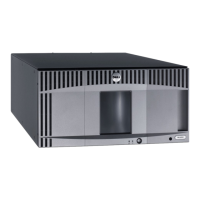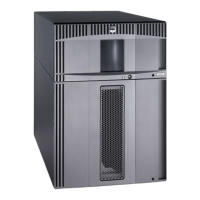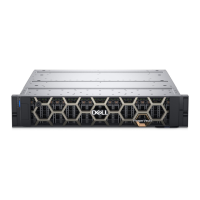Configuring Your Library
file:///T|/htdocs/stor-sys/ML6000/en/html/ch04.htm[9/17/2012 1:49:29 PM]
• The requested topology connection mode can be set to one of the following:
• Auto (LN) — Auto-configure trying L-Port first
• Loop (L) — Force L-Port
• Point to Point — Force N-Port
• Auto (NL) — Auto-configure trying N-Port first (default)
Notes about Point to Point:
- You can use Point to Point if the tape drive is connected via a switch or directly to a host.
- You cannot use Point to Point if the tape drive is connected to an FC I/O blade.
• The requested interface speed can be set to Auto (default), 1 Gb/s, 2 Gb/s, 4 Gb/s, or 8 Gb/s (depending on drive
type).
Caution: LTO-5 Fibre Channel tape drives can be configured for speeds of up to 8 Gb/s. If they are configured
for 8 Gb/s, you should connect them directly to a host and not to an FC I/O blade, because the FC I/O blade only
allows speeds up to 4 Gb/s. If you connect an LTO-5 Fibre Channel tape drive to an FC I/O blade, you must
configure the tape drive speed to 4 Gb/s or less.
• If the requested FC topology and speed settings are not supported, the next appropriate settings are negotiated. On
the Web client, the Drive Settings screen displays both the requested and the actual FC topology connection mode
and interface speed. If FC drives are not connected to the host, the negotiated actual settings appear on the screen as
"unknown."
Note: On the Web client, the Drive Settings screen displays tape drive information in tables. Bold column headings
in the tables can be sorted. For example, selecting the Location column heading will sort by location coordinates.
The paths to open the appropriate screens are as follows:
• From the Web client, select Setup > Drive Settings.
• From the operator panel, select Setup > Drive Settings.
Working With Control Paths
The control path tape drive is used to connect partition to a host application.
The library automatically assigns control paths when you set up partitions. You can modify the control path at any time. Table
3 describes how these control paths are assigned and how to change them.
Table 3 Control Path Assignment During Partition Creation
If the
library
contains:
And the
partition
contains:
Then the
default
control path
for the
partition is: If you want to change the control path, note the following:
No FC I/O
blades
Any combination
of tape drive
interface types
(SCSI, FC, or
SAS)
The first tape
drive
assigned to
the partition
You must select a tape drive as the control path.
One or
more FC
I/O
blades
At least one FC
tape drive
The FC I/O
blade
It is recommended that you allow the FC I/O blade to be the control path for
the partition.
(You can select a tape drive as control path if the tape drive is not connected
to an FC I/O blade; however, your host will end up seeing multiple medium
changers. In addition, using the FC I/O blade as the control path allows you to
utilize the LUN mapping and host port failover features.)
One or
more FC
No FC tape
drives
The first tape
drive
You must select a tape drive as the control path.

